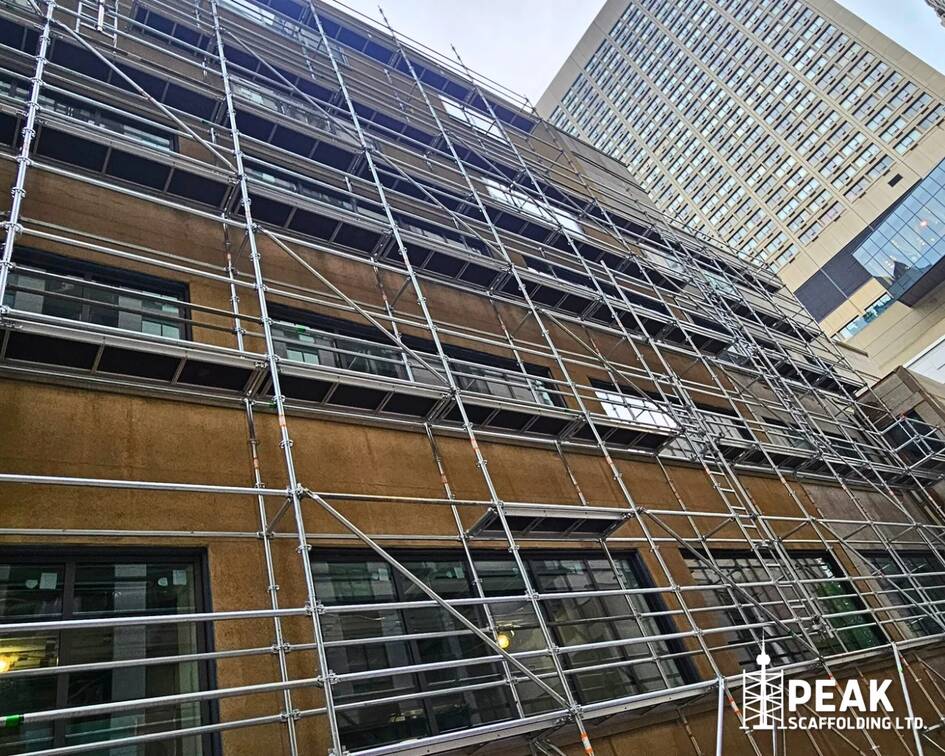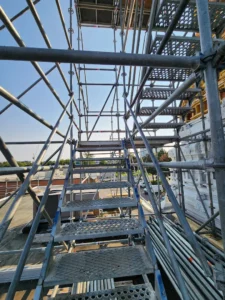Introduction

Toronto’s iconic skyline is undergoing a transformation. It’s not just about reaching new heights; it’s about building a more sustainable future. The city’s ambitious green building initiatives are paving the way for a greener, more energy-efficient cityscape. Amidst the focus on eco-friendly materials and innovative designs, scaffolding might seem like a mere construction tool. However, it plays a surprisingly vital role in enabling these green building projects.
From facilitating energy-efficient retrofits to supporting the use of sustainable materials, scaffolding is an essential component of Toronto’s journey towards a greener built environment. In this article, we’ll delve into the multifaceted ways scaffolding contributes to sustainable construction practices and how PEAK Scaffolding, as a local leader in the industry, is committed to supporting Toronto’s green building initiatives.
Scaffolding and Energy Efficiency: Building a Greener Tomorrow
Older buildings in Toronto often lack the energy efficiency of modern construction. Retrofitting these structures with insulation, energy-efficient windows, and renewable energy systems is a crucial step towards reducing carbon emissions and creating a more sustainable city. Scaffolding provides the essential access and support needed for these energy-saving upgrades.
How Scaffolding Enables Energy-Efficient Retrofits:
- Insulation Installation: Installing insulation in exterior walls or roofs requires safe and secure access at height. Scaffolding provides a stable platform for workers to install insulation materials effectively, ensuring a continuous thermal envelope that reduces heat loss and energy consumption.
- Window Replacements: Replacing old, drafty windows with energy-efficient ones is a common retrofit strategy. Scaffolding allows workers to access windows at any height, ensuring proper installation and minimizing disruption to building occupants.
- Solar Panel Installations: Harnessing solar energy is a key component of green building. Scaffolding provides a secure platform for installing solar panels on rooftops or facades, maximizing energy production and reducing reliance on fossil fuels.
- Energy Audits and Assessments: Before implementing energy-saving measures, thorough audits and assessments are essential. Scaffolding allows professionals to safely access all areas of the building, identifying areas for improvement and ensuring accurate data collection.
At PEAK Scaffolding, we’re proud to have supported numerous energy-efficiency projects across Toronto. Our expertise in designing and installing scaffolding systems tailored to these specific needs ensures that retrofitting work is carried out safely and efficiently.
Waste Reduction and Recycling through Scaffolding: Building with Less Impact
In the pursuit of greener construction practices, reducing waste and maximizing recycling are crucial considerations. Scaffolding, often seen as a temporary structure, can actually play a significant role in minimizing waste and promoting efficient material management on construction sites.
Efficient Material Handling
Imagine a construction site without scaffolding. Workers would constantly be moving materials up and down ladders, increasing the risk of drops, spills, and damage. Scaffolding provides a secure and organized platform for storing and transporting materials, reducing the likelihood of waste due to mishandling or accidental damage.
Additionally, with a well-designed scaffolding system, materials can be hoisted directly to the work area, minimizing the need for manual handling and reducing the potential for damage during transport.
Deconstruction and Salvage Operations
Green building often involves deconstructing existing structures rather than demolishing them. This allows for the salvage and reuse of valuable materials, reducing the demand for new resources and minimizing waste sent to landfills.
Scaffolding is indispensable in deconstruction projects, providing safe access for workers to carefully dismantle buildings and salvage reusable components like bricks, beams, and flooring. By enabling selective demolition, scaffolding contributes to a more sustainable approach to construction.
PEAK Scaffolding's Commitment to Waste Reduction
At PEAK Scaffolding, we’re dedicated to supporting green building initiatives through responsible practices. We carefully plan our scaffolding installations to minimize material usage and ensure efficient dismantling processes. We also work closely with our clients to identify opportunities for material reuse and recycling.
By partnering with PEAK Scaffolding, you can be confident that your scaffolding needs are being met with a focus on sustainability. We’re committed to helping you achieve your green building goals and minimize the environmental impact of your construction project.
Scaffolding & Sustainable Construction Materials: Enabling a Greener Build

The choice of construction materials significantly impacts the sustainability of a building. Toronto’s green building initiatives encourage the use of eco-friendly materials that minimize environmental impact and promote resource efficiency. Scaffolding plays a crucial role in enabling the incorporation of these sustainable materials into building projects.
Access for Green Features
Many green building features require specialized installation techniques or access to specific areas of a structure. Scaffolding provides the necessary platform for workers to safely and efficiently install these elements, contributing to a more sustainable building.
- Green Roofs: Installing a green roof, a layer of vegetation on a rooftop, requires careful placement of soil, plants, and irrigation systems. Scaffolding provides access to the roof surface, allowing workers to complete the installation without damaging the building or compromising safety.
- Living Walls: Vertical gardens or living walls add greenery to building facades, improving air quality and aesthetics. Scaffolding offers a secure platform for installing and maintaining these living systems, ensuring their long-term health and beauty.
- Solar Panels: As mentioned earlier, scaffolding is essential for installing solar panels on rooftops or facades. It allows for safe access and precise positioning of these renewable energy systems.
Handling Specialized Materials
Sustainable construction materials often require specialized handling or installation techniques. Scaffolding provides the necessary support and access for working with these materials, ensuring their proper integration into the building structure.
- Recycled Materials: Recycled bricks, timber, or metal can be incorporated into building projects, reducing the demand for new resources. Scaffolding facilitates the safe handling and placement of these materials, even in challenging locations.
- Prefabricated Components: Prefabricated elements, built off-site with greater precision and efficiency, are becoming increasingly popular in sustainable construction. Scaffolding provides the necessary support for assembling these components on-site, minimizing waste and reducing construction time.
- Innovative Materials: New sustainable materials are constantly emerging, each with unique properties and installation requirements. Scaffolding’s adaptability allows it to accommodate these innovations, enabling builders to explore and implement cutting-edge green solutions.
Safety and Sustainability: A Connected Approach
While often considered separate concerns, safety and sustainability are intrinsically linked in the realm of construction. Green building initiatives aim to create a better future for our planet, but that future must also be safe for the workers who bring these projects to life.
Safe Scaffolding for a Sustainable Future
Scaffolding safety plays a critical role in achieving sustainable construction goals. Accidents and injuries on construction sites can lead to:
- Project Delays: Accidents disrupt workflows, cause delays, and lead to increased material waste and energy consumption.
- Increased Costs: Medical expenses, insurance claims, and potential legal fees can strain project budgets.
- Environmental Impact: Delays and disruptions can lead to extended construction periods, resulting in greater energy use and emissions.
By prioritizing scaffolding safety, we ensure that workers can focus on sustainable construction practices without jeopardizing their well-being. A safe work environment allows for greater efficiency, reduced waste, and a smoother project timeline, all contributing to a more sustainable outcome.
PEAK Scaffolding's Commitment to Safety
At PEAK Scaffolding, we understand that safety and sustainability go hand in hand. Our unwavering commitment to safety isn’t just about protecting workers; it’s about creating a work environment that fosters efficiency, minimizes waste, and supports the overall success of your green building initiatives.
- Rigorous Training and Certification: Our team undergoes continuous training and certification to stay abreast of the latest safety practices and regulations.
- Thorough Inspections and Maintenance: We conduct regular inspections of our scaffolding systems to identify and address any potential hazards, ensuring ongoing safety throughout your project.
- Proactive Risk Assessment: We perform comprehensive risk assessments before every project to identify and mitigate potential safety risks, promoting a proactive safety culture.
By choosing PEAK Scaffolding, you’re not only getting a safe and reliable scaffolding solution; you’re also gaining a partner dedicated to supporting your sustainable construction practices. We believe that a safe work environment is essential for building a greener future, and we’re committed to helping you achieve your green building goals without compromising on worker safety.
The Future of Scaffolding in Sustainable Construction: Building Greener, Higher
As Toronto continues to embrace green building practices, the scaffolding industry is evolving to meet the demands of a more sustainable future. New technologies, materials, and design approaches are emerging, making scaffolding even more eco-friendly and efficient.
Emerging Trends in Sustainable Scaffolding
- Recycled and Recyclable Materials: Traditional scaffolding materials like steel and aluminum are already highly recyclable. However, there’s a growing trend towards using recycled content in scaffolding components, reducing the need for virgin materials and minimizing environmental impact.
- Innovative Designs: New scaffolding designs are focusing on reducing weight and optimizing transportation and storage, leading to decreased fuel consumption and emissions. Modular systems like the Ringlock System are inherently efficient in this regard, minimizing waste and simplifying logistics.
- Technology Integration: Digital tools and technologies are being incorporated into scaffolding design, installation, and maintenance. This can improve efficiency, reduce errors, and minimize material waste. For instance, 3D modeling and virtual reality can help optimize scaffolding layouts and identify potential issues before construction begins.
PEAK Scaffolding's Vision for a Greener Future
At PEAK Scaffolding, we’re excited about the potential of sustainable scaffolding to contribute to a greener construction industry. We’re committed to staying at the forefront of these emerging trends and incorporating eco-friendly practices into our operations.
We believe that sustainability and safety go hand in hand. By choosing innovative scaffolding solutions and prioritizing responsible practices, we can help build a brighter future for Toronto – one that’s both environmentally conscious and safe for everyone involved in the construction process.
Conclusion: Scaffolding as a Catalyst for Green Building in Toronto
Scaffolding is more than just a temporary structure; it’s a catalyst for progress, enabling the construction of a more sustainable and resilient Toronto. From facilitating energy-efficient retrofits to supporting the use of eco-friendly materials, scaffolding plays a vital role in achieving the city’s green building goals.
As you embark on your next construction project, consider the environmental impact of your scaffolding choices. Partnering with a company like PEAK Scaffolding ensures that your access solutions align with your sustainability objectives.
Remember, every project is an opportunity to build a greener future. Let’s work together to create a Toronto where innovation, safety, and sustainability thrive.
Ready to take the next step? Contact PEAK Scaffolding today to discuss your scaffolding needs and how we can support your green building initiatives.
Related Posts


Toronto Building Codes and Scaffolding: What You Must Comply With




